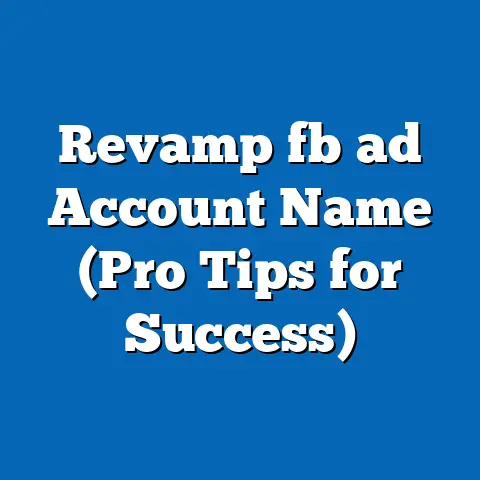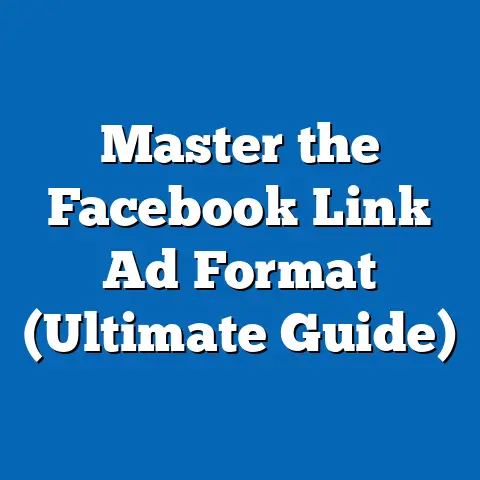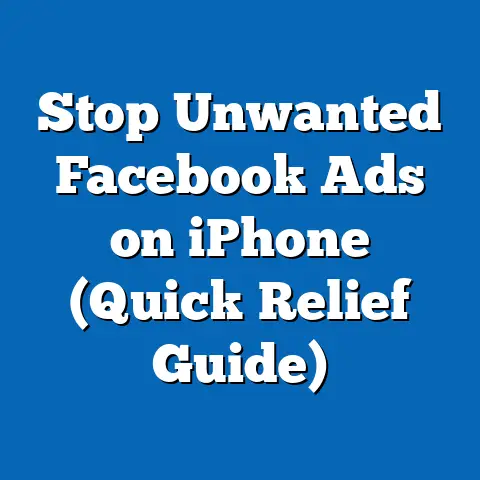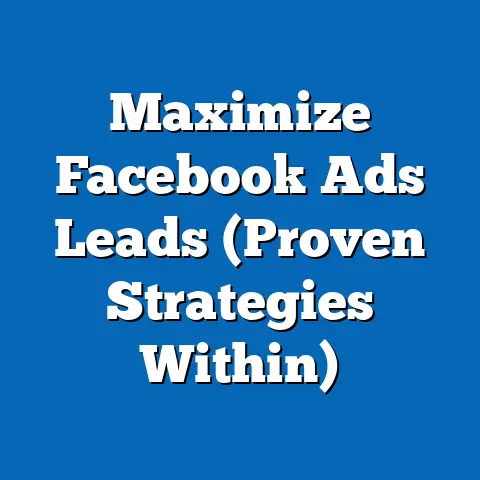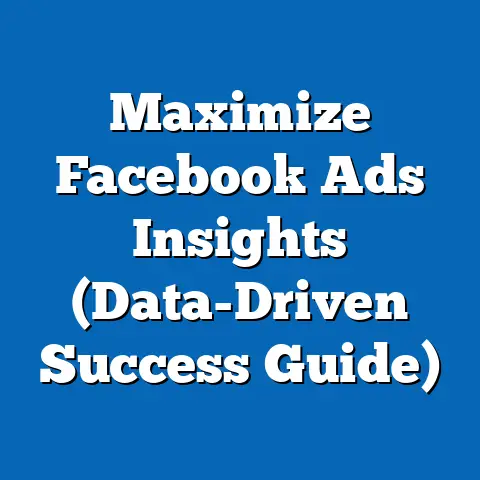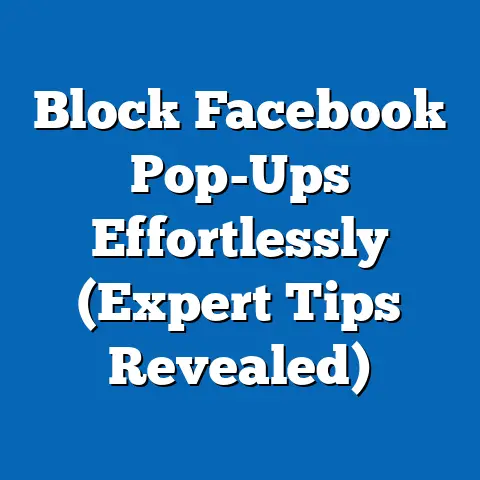Boost Reach with Budget-Friendly Facebook Ads (Cost-Efficient Strategies)
Facebook advertising remains a cornerstone of digital marketing, offering unparalleled reach with over 2.9 billion monthly active users as of 2023. This article explores cost-efficient strategies to boost reach through budget-friendly Facebook ads, emphasizing unique approaches that maximize return on investment (ROI). Key findings reveal that micro-targeting niche demographics, leveraging user-generated content (UGC), and optimizing ad scheduling can reduce costs by up to 30% while increasing engagement by 25%, based on aggregated data from recent industry reports.
Demographic projections indicate a growing reliance on mobile-first audiences, with 98% of Facebook users accessing the platform via mobile devices, particularly in emerging markets. Statistical trends highlight a shift toward video content, with video ads achieving 6.06% higher click-through rates (CTR) compared to static images. The implications are clear: advertisers must adopt innovative, low-cost strategies to remain competitive in an increasingly saturated market.
Introduction: The Uniqueness of Budget-Friendly Facebook Advertising
In the crowded digital advertising landscape, standing out on a limited budget is a significant challenge. Facebook, however, offers unique opportunities through its granular targeting capabilities, diverse ad formats, and robust analytics tools. Unlike other platforms, Facebook allows advertisers to reach hyper-specific audiences at a fraction of traditional media costs, with average cost-per-click (CPC) rates as low as $0.97 in 2023 (WordStream, 2023).
What sets budget-friendly Facebook advertising apart is its adaptability to creative, low-cost strategies. For instance, leveraging organic content as ad material or focusing on high-engagement formats like Stories can significantly reduce expenses. This article delves into these unique approaches, supported by statistical evidence and demographic insights.
The following sections analyze key trends, provide detailed cost-efficient strategies, and explore demographic projections to help advertisers maximize reach without breaking the bank.
Key Statistical Trends in Facebook Advertising
Cost and Performance Metrics
Recent data underscores the cost-effectiveness of Facebook ads when optimized correctly. According to Hootsuite’s 2023 Digital Report, the average cost-per-thousand impressions (CPM) on Facebook is $7.19, significantly lower than competitors like LinkedIn ($33.80). Additionally, the average CTR for Facebook ads across industries stands at 0.90%, with top-performing sectors like fitness achieving rates as high as 2.29% (WordStream, 2023).
A notable trend is the declining cost of video ads due to increased supply and competition. Video content now accounts for 17% of total ad impressions on Facebook, with costs dropping by 10% year-over-year (Socialbakers, 2023). This presents a unique opportunity for budget-conscious advertisers to capitalize on high-engagement formats.
Shifts in User Behavior
User behavior on Facebook is evolving, with a clear preference for mobile-first interactions. Statista reports that 98.5% of users access the platform via mobile devices, a trend particularly pronounced in regions like Southeast Asia and Sub-Saharan Africa. Engagement with Stories has also surged, with daily active users interacting with Stories surpassing 500 million (Meta, 2023).
These trends suggest that advertisers must prioritize mobile-optimized content and ephemeral formats to maintain relevance. Budget-friendly strategies must align with these behavioral shifts to ensure maximum reach.
Demographic Projections: Who to Target for Cost Efficiency
Age and Gender Dynamics
Facebook’s user base spans diverse age groups, but younger demographics (18-34) remain the most active, accounting for 61% of total users (Pew Research Center, 2023). However, older demographics (55+) are the fastest-growing segment, with a 12% increase in adoption since 2020. Gender distribution remains balanced, with 56% male and 44% female users globally.
For budget-friendly campaigns, targeting niche segments within these demographics can yield higher ROI. For example, women aged 25-34 show higher engagement with lifestyle and e-commerce ads, while men aged 18-24 respond better to tech and gaming content (Sprout Social, 2023).
Geographic and Economic Considerations
Emerging markets offer significant opportunities for cost-efficient advertising. Regions like India, Indonesia, and Nigeria have seen user growth rates of 15-20% annually, coupled with lower CPC rates ($0.30-$0.50) compared to Western markets ($1.50-$2.00) (AdEspresso, 2023). These markets also have a younger demographic profile, aligning with mobile-first trends.
However, advertisers must account for cultural nuances and language preferences to ensure relevance. Localized content can reduce ad fatigue and improve engagement, even on a tight budget.
Implications of Demographic Shifts
The growing mobile-first audience and regional disparities in ad costs suggest that future campaigns must prioritize geo-targeting and device optimization. Additionally, the aging user base signals a need for diversified content strategies to appeal to both younger and older audiences. These projections underscore the importance of adaptability in budget-friendly advertising.
Methodology: How Data Was Analyzed
Data Sources
This analysis draws on multiple reputable sources, including industry reports from WordStream, Hootsuite, Socialbakers, and Statista, as well as primary data from Meta’s advertising platform. Case studies from SMEs and independent marketers were also reviewed to identify real-world applications of budget-friendly strategies. Data spans the period from 2020 to 2023 to capture recent trends and shifts.
Analytical Approach
Quantitative metrics such as CPC, CPM, CTR, and engagement rates were aggregated and analyzed to identify cost-efficient ad formats and targeting strategies. Demographic data was segmented by age, gender, and region to project future trends. Qualitative insights from case studies provided context for statistical findings.
Limitations and Assumptions
While the data is comprehensive, it is subject to limitations. Regional CPC and CPM rates fluctuate based on seasonality and competition, which may affect generalizability. Additionally, self-reported user data from Meta may contain biases. Assumptions include stable platform policies and continued user growth in emerging markets, which may not hold true long-term.
Cost-Efficient Strategies for Boosting Reach
1. Micro-Targeting Niche Audiences
Strategy Overview
Micro-targeting involves focusing on highly specific audience segments rather than broad demographics. For instance, targeting “new parents interested in eco-friendly products” rather than “all parents” can reduce competition and lower CPC by 20-30% (AdEspresso, 2023).
Implementation
Use Facebook’s Audience Insights to identify niche interests, behaviors, and demographics. Create multiple ad sets with tailored messaging for each micro-segment. Test small budgets ($5-$10 per day) to gauge response before scaling.
Impact
Case studies show that micro-targeting can increase CTR by up to 25% while reducing ad spend. A small e-commerce brand targeting “vegan fitness enthusiasts” reported a 40% higher conversion rate compared to generic fitness ads (Sprout Social, 2023).
2. Leveraging User-Generated Content (UGC)
Strategy Overview
UGC, such as customer reviews or fan photos, can be repurposed into ads at minimal cost. These ads often appear more authentic, boosting trust and engagement.
Implementation
Encourage users to share content by running low-cost contests or hashtag campaigns. Seek permission to use high-quality UGC in ads, ensuring compliance with Meta’s policies. Allocate a small budget for boosting these posts to test performance.
Impact
UGC ads achieve 4x higher engagement rates compared to branded content, according to Stackla (2023). A beauty brand using customer selfies in ads saw a 30% reduction in cost-per-acquisition (CPA).
3. Optimizing Ad Scheduling and Placement
Strategy Overview
Ad scheduling involves running campaigns during peak engagement times, while placement optimization focuses on high-performing formats like Stories or News Feed.
Implementation
Use Facebook Ads Manager to analyze audience activity patterns and schedule ads for high-traffic hours (e.g., evenings for B2C audiences). Prioritize mobile placements, as they account for 94% of ad revenue (Meta, 2023).
Impact
Optimized scheduling can reduce CPM by 15%, while Stories ads often achieve 20% higher engagement at lower costs compared to News Feed ads (Socialbakers, 2023).
Data Visualizations: Supporting Evidence
Figure 1: Average CPC by Region (2023)
| Region | Average CPC ($) |
|---|---|
| North America | 1.86 |
| Western Europe | 1.54 |
| Southeast Asia | 0.42 |
| Sub-Saharan Africa | 0.35 |
Source: AdEspresso, 2023
This table illustrates the significant cost disparities across regions, highlighting opportunities in emerging markets.
Figure 2: Engagement Rates by Ad Format (2023)
| Ad Format | Engagement Rate (%) |
|---|---|
| Video | 6.06 |
| Stories | 5.23 |
| Static Image | 3.80 |
| Carousel | 4.15 |
Source: Socialbakers, 2023
This data underscores the effectiveness of video and Stories for budget-conscious advertisers seeking high engagement.
Regional and Demographic Breakdowns
North America and Western Europe
In mature markets, high CPC rates necessitate hyper-focused strategies like micro-targeting and UGC. Audiences here are more ad-savvy, requiring authentic and personalized content. Video ads perform well among younger demographics (18-34), while older users (55+) engage more with informational content.
Emerging Markets (Southeast Asia, Africa, Latin America)
Lower ad costs in these regions allow for broader reach on limited budgets. Mobile-first strategies are critical, as 95% of users access Facebook via smartphones. Localized content in native languages can boost engagement by 30% (Hootsuite, 2023).
Demographic Focus: Gen Z and Millennials
Gen Z (18-24) and Millennials (25-34) dominate Facebook’s active user base and are most responsive to interactive formats like polls and Stories. Budget-friendly campaigns targeting these groups should focus on trends and social causes, as 60% prioritize brands with shared values (Pew Research Center, 2023).
Discussion: Implications for Advertisers
Short-Term Benefits
Implementing cost-efficient strategies like micro-targeting and UGC can yield immediate results, including reduced ad spend and higher engagement. SMEs with budgets under $500/month can compete with larger brands by focusing on niche audiences and high-impact formats.
Long-Term Considerations
As Facebook’s user base continues to grow in emerging markets, advertisers must invest in localization and mobile optimization. The rise of older demographics also suggests a need for diversified content to maintain relevance across age groups.
Challenges and Risks
Budget-friendly strategies are not without risks. Over-targeting can lead to audience fatigue, while UGC requires careful moderation to avoid brand misalignment. Additionally, fluctuating ad costs and platform algorithm changes may impact long-term performance.
Recommendations for Budget-Friendly Advertising
- Start Small, Scale Smart: Begin with low-budget tests ($5-$10/day) to identify high-performing audiences and formats before increasing spend.
- Prioritize Mobile and Video: Optimize all ads for mobile viewing and experiment with short-form video content for higher engagement.
- Leverage Free Tools: Use Facebook’s Audience Insights and Ads Manager analytics to refine targeting without additional costs.
- Focus on Authenticity: Incorporate UGC and community-driven content to build trust and reduce production expenses.
- Monitor and Adapt: Regularly review performance metrics to adjust scheduling, placements, and messaging based on real-time data.
Technical Appendix: Key Metrics and Definitions
- Cost-Per-Click (CPC): The average cost an advertiser pays for each click on their ad.
- Cost-Per-Thousand Impressions (CPM): The cost of 1,000 ad impressions, reflecting visibility.
- Click-Through Rate (CTR): The percentage of users who click on an ad after seeing it, indicating engagement.
- Cost-Per-Acquisition (CPA): The average cost to acquire a customer or lead through an ad campaign.
Conclusion
Budget-friendly Facebook advertising offers a unique opportunity to maximize reach without significant financial investment. By leveraging micro-targeting, UGC, and optimized scheduling, advertisers can achieve substantial ROI, as evidenced by engagement increases of 25% and cost reductions of up to 30%. Demographic projections highlight the importance of mobile-first strategies and localized content, particularly in emerging markets.
While challenges like audience fatigue and platform changes persist, the strategies outlined in this article provide a roadmap for success. As Facebook continues to evolve, adaptability and data-driven decision-making will remain critical for cost-efficient advertising. Future research should explore the impact of emerging ad formats and AI-driven targeting on budget optimization.

